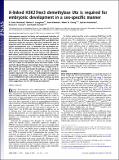X-linked H3K27me3 demethylase Utx is required for embryonic development in a sex-specific manner
Author(s)
Welstead, G. Grant; Creyghton, Menno P.; Bilodeau, Steve; Markoulaki, Styliani; Young, Richard A.; Jaenisch, Rudolf; Cheng, Albert Wu; ... Show more Show less
DownloadWelstead-2012-X-linked H3K27me3 de.pdf (786.4Kb)
PUBLISHER_POLICY
Publisher Policy
Article is made available in accordance with the publisher's policy and may be subject to US copyright law. Please refer to the publisher's site for terms of use.
Terms of use
Metadata
Show full item recordAbstract
Embryogenesis requires the timely and coordinated activation of developmental regulators. It has been suggested that the recently discovered class of histone demethylases (UTX and JMJD3) that specifically target the repressive H3K27me3 modification play an important role in the activation of “bivalent” genes in response to specific developmental cues. To determine the requirements for UTX in pluripotency and development, we have generated Utx-null ES cells and mutant mice. The loss of UTX had a profound effect during embryogenesis. Utx-null embryos had reduced somite counts, neural tube closure defects and heart malformation that presented between E9.5 and E13.5. Unexpectedly, homozygous mutant female embryos were more severely affected than hemizygous mutant male embryos. In fact, we observed the survival of a subset of UTX-deficient males that were smaller in size and had reduced lifespan. Interestingly, these animals were fertile with normal spermatogenesis. Consistent with a midgestation lethality, UTX-null male and female ES cells gave rise to all three germ layers in teratoma assays, though sex-specific differences could be observed in the activation of developmental regulators in embryoid body assays. Lastly, ChIP-seq analysis revealed an increase in H3K27me3 in Utx-null male ES cells. In summary, our data demonstrate sex-specific requirements for this X-linked gene while suggesting a role for UTY during development.
Date issued
2012-07Department
Massachusetts Institute of Technology. Computational and Systems Biology Program; Massachusetts Institute of Technology. Department of Biology; Whitehead Institute for Biomedical ResearchJournal
Proceedings of the National Academy of Sciences of the United States of America
Publisher
National Academy of Sciences (U.S.)
Citation
Welstead, G. G. et al. “X-linked H3K27me3 Demethylase Utx Is Required for Embryonic Development in a Sex-specific Manner.” Proceedings of the National Academy of Sciences 109.32 (2012): 13004–13009. © 2012 National Academy of Sciences
Version: Final published version
ISSN
0027-8424
1091-6490